Make a Commitment to Conservation in 2017
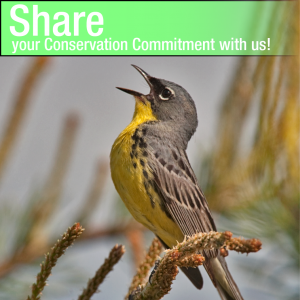 The threats to birds are many and the trajectory for some of our most beloved Michigan species is not positive. Nearly everything that threatens our birds is human-driven: urbanization; invasive species; windows; lights; unsustainable consumerism; and, perhaps worst of all, nature deficit disorder. These human-driven threats have human-driven solutions. No matter your background, interests, or experience, there is an action you can take to make the world better for birds. Your action may inspire a friend, a family member, or your neighbor to take action as well. We at Michigan Audubon invite you to make 2017 a year for conservation action – let’s each make a pledge for birds!
The threats to birds are many and the trajectory for some of our most beloved Michigan species is not positive. Nearly everything that threatens our birds is human-driven: urbanization; invasive species; windows; lights; unsustainable consumerism; and, perhaps worst of all, nature deficit disorder. These human-driven threats have human-driven solutions. No matter your background, interests, or experience, there is an action you can take to make the world better for birds. Your action may inspire a friend, a family member, or your neighbor to take action as well. We at Michigan Audubon invite you to make 2017 a year for conservation action – let’s each make a pledge for birds!
You won’t be alone in your conservation-minded pursuits; we’ll help you. We’ve put together 5 broad categories of pledges for you to explore, each containing a variety of actions for every type of bird aficionado. Get inspired by our suggestions or feel free to customize your own pledge for birds.
I am only one, but I am one. I cannot do everything, but I can do something. And because I cannot do everything, I will not refuse to do the something that I can do. —Edward Everett Hale
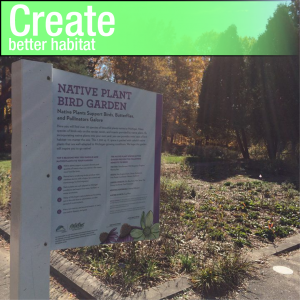 CREATE better habitat
CREATE better habitat
The greatest threat to birds is habitat loss. While we often look to preserves and protected lands to support wildlife, there are millions of acres with great potential that we consistently overlook—urban spaces. Backyards, curbsides, ditches, urban parks, and suburban lawns are bursting with opportunity; but we must terminate our love affair with turf. Put on your habitat-tinted glasses and re-imagine that “hellstrip” between the curb and sidewalk. Replace that swath of manicured lawn with a strip of sunset orange butterfly milkweed, swaying little bluestem grass, and delicate foxglove. Think of that ditch you awkwardly mow (when it isn’t sopping wet) and imagine dark purple asters, pink swamp milkweed, or a burst of red cardinal flower. Imagine your workplace, church, or school—is there a place where butterflies flit and birds find refuge?
Explore the links below for a variety of resources to help you create better habitat in 2017!
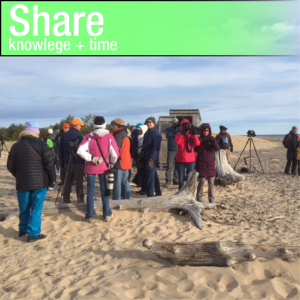 SHARE knowledge + time
SHARE knowledge + time
We each have experience, knowledge, and passion to share with others. At a time when nature deficit disorder is a concern for both children and adults, it is more important than ever to share our appreciation for nature and engage others to explore the natural world with us. If you have children, grandchildren, nieces or nephews, or other young people in your life, introduce them to birds. Whether through coloring books, stories, feeder watching, or nature walks, there are many ways to engage young people in birding. Even if you aren’t an expert birder, just sharing your appreciation for nature with others is incredibly valuable. Organize casual bird walks at a local park, start a coffee or book club for bird and nature lovers, gather a volunteer group to adopt a native garden or nest box trail, or offer your skills as a writer, illustrator, orator, or filmmaker to a nonprofit. We each can make a unique contribution to bird conservation.
Explore the links below for helpful tips regarding how to share your knowledge and time for bird conservation.
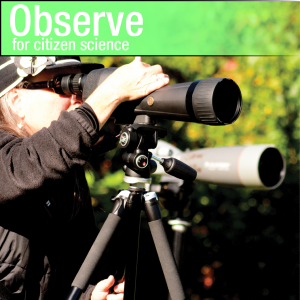 OBSERVE for citizen science
OBSERVE for citizen science
Citizen science has opened up a world of science and discovery to millions of observant people. Our curious nature drives us to take note of which birds we are seeing, where, when, and how many. These local observations piece together to form a full, landscape-wide picture of the status of bird species. The opportunities to contribute to research and conservation by gathering data from the world around us are endless. No matter the season, location, age or experience level, there is a type of citizen science project fit for everyone. Researchers have utilized results from these citizen science projects to detect long-term population declines, range expansions, migration shifts, and much more. Your contributions are valuable for bird conservation locally, regionally, and worldwide.
Explore the links below to learn about a variety worthy citizen science efforts.
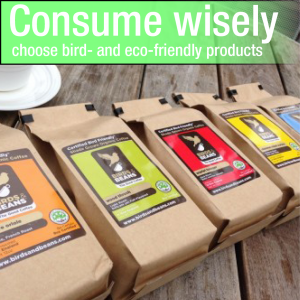 CONSUME WISELY choose bird-friendly products
CONSUME WISELY choose bird-friendly products
As consumers, we make a statement with our wallets. Where we choose to invest money reflects our personal values. We focus many of our conservation efforts on issues here in Michigan, mostly regarding breeding birds, but many of our actions as consumers impact migratory birds on the wintering grounds or birds that we may never interact with, but also need our help. Shade-grown coffee plantations support a significantly greater diversity and number of birds compared with aggressive sun-grown plantations. Pelagic species are consuming bits of algae-scented plastic and filling the bellies of their young with indigestible refuse. Making well-informed purchasing decisions sends a clear economic message – birders are willing to invest in sustainable, bird-friendly products and markets.
Explore the links below for suggestions about choosing bird- and eco-friendly products.
 BE A VOICE for change
BE A VOICE for change
We live in an ever-changing world where many of the governing bodies are out of touch with nature and the needs of the environment. It is our responsibility to inform decision makers that we as constituents value birds, nature, and the environment and their protection is important to us. The birds cannot write to their congressmen and women; we must speak up for them. There is no need to grab a sign and picket, but it’s important to be informed about the issues at hand. Get involved with policy at the local, state, and federal level and be an informed voter or write letters, op-eds, or statements to present at planning commission meetings. Give a voice to birds in a respectful, engaging way to be a successful advocate for birds.
Explore the links below for actions you can take to be a voice for birds.

